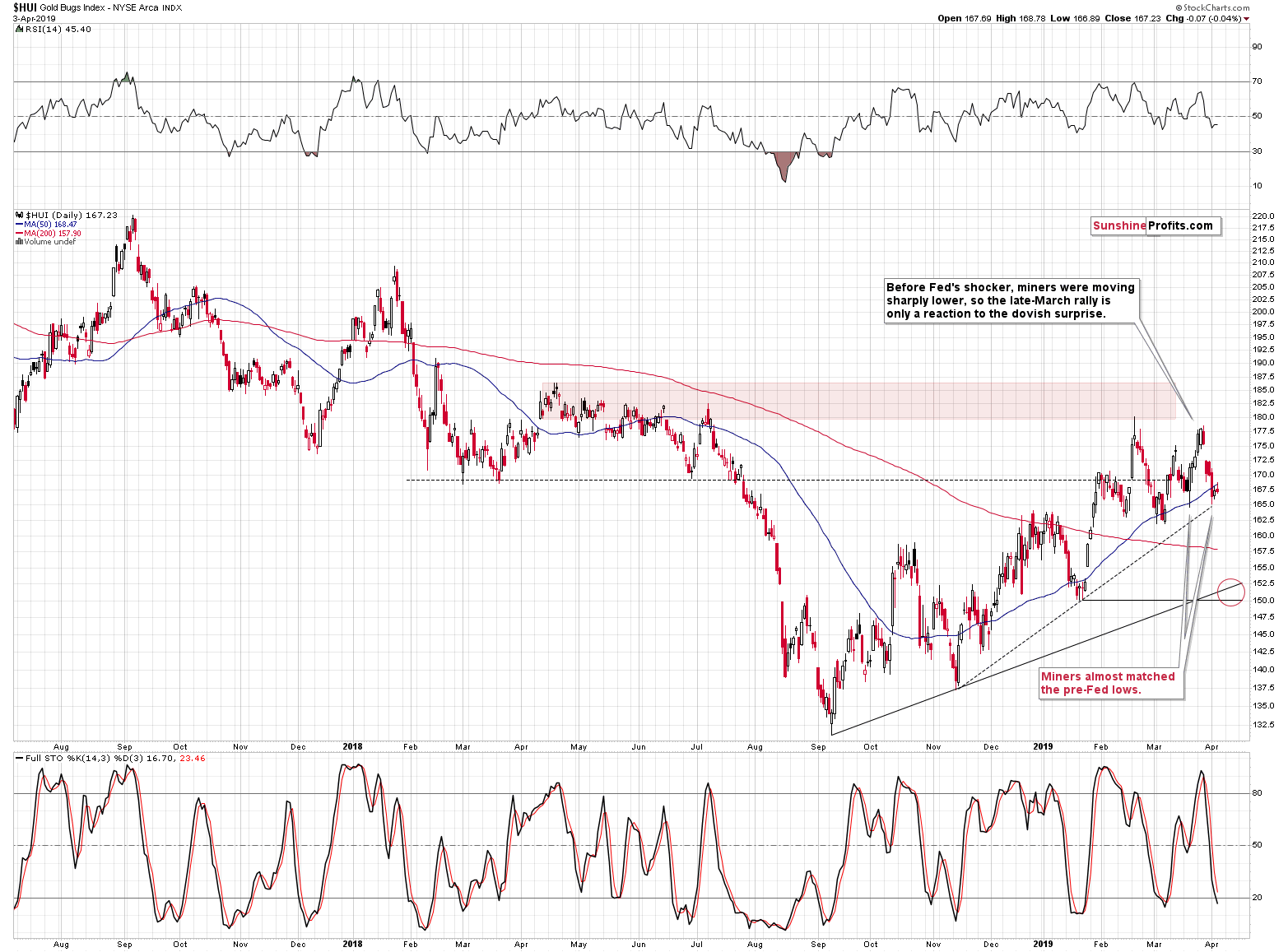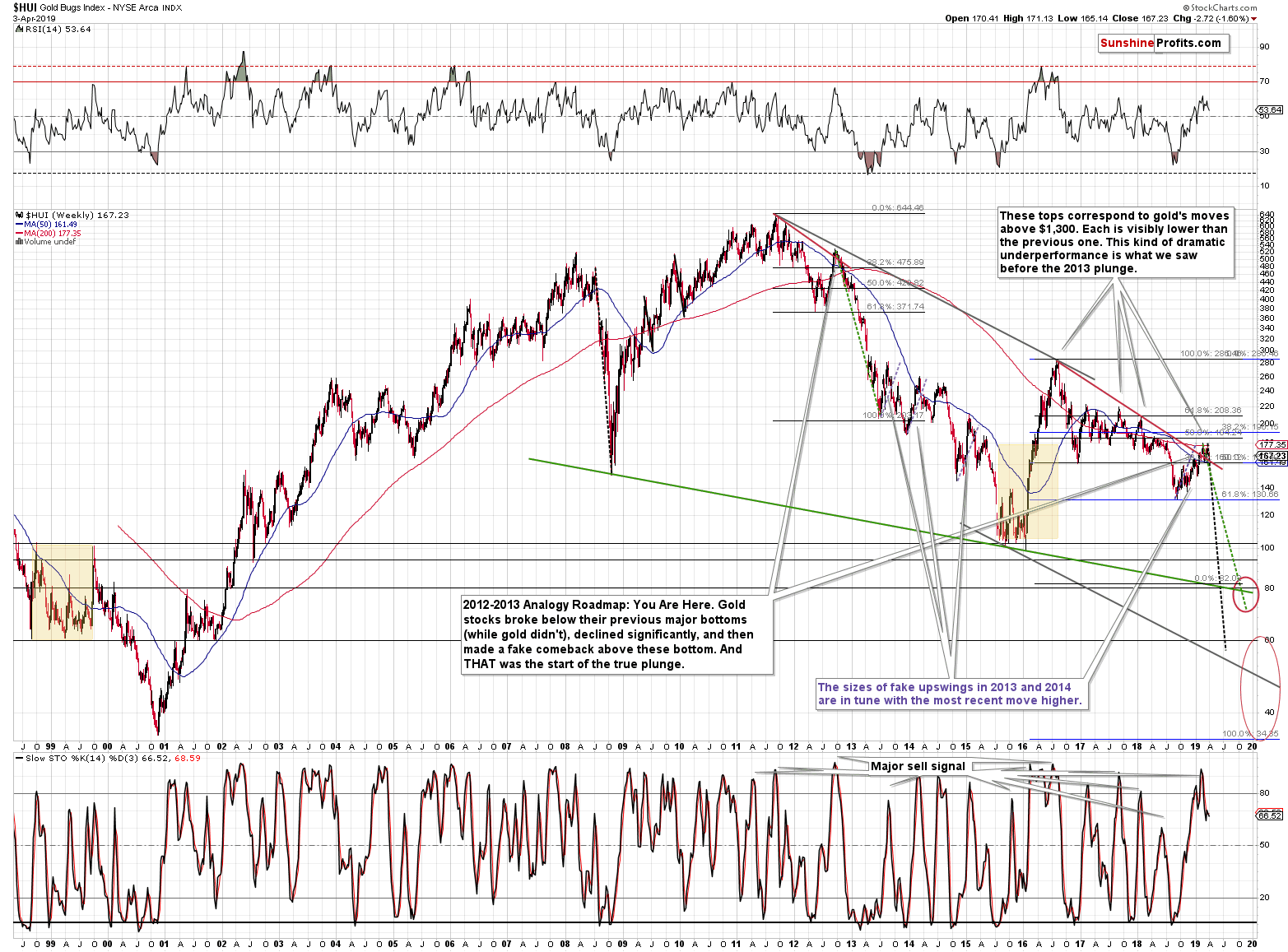Briefly: in our opinion, full (250% of the regular size of the position) speculative short position in gold, silver, and mining stocks is justified from the risk/reward perspective at the moment of publishing this Alert.
Silver stocks took the spotlight yesterday and in today’s analysis, we’re going to balance the attention to the mining stocks with the focus on gold equities. Their moves from both: short- and long-term points of view are very informative. We will also update you on our targets for the HUI Index, for both: short- and medium term.
Let’s start with the short-term picture.
Gold Stocks’ Breakdown and Its Verification
The HUI Index moved higher yesterday, touched its 50-day moving average and then turned south once again. The breakdown below it has been verified. Since the 50-day MA is currently almost exactly at the mid-March low in terms of the closing prices, we can say that the breakdown below it has also been verified.
The interesting thing about this verification with regard to the 50-day MA is that it’s the first verification that took this classic form ever since the medium-term move higher had started. In late October, there was some back-and-forth the movement around the MA. In mid-November, there was one decisive breakdown, but it was not verified in the above-mentioned manner. In late November, there were only single session below the 50-day moving average, which were quickly invalidated. The mid-January move below the MA was rather small and without a classic comeback to the MA that would be then followed by a decline. The March attempts to break lower were quickly invalidated.
In terms of shape, the current breakdown below the 50-day MA is already different from all the previous attempts. In terms of time, this is not yet the case. The longest move below the MA that was then invalidated took four days. We saw that twice – in mid-November and in mid-January. Given today’s pre-market decline in the precious metals, today will probably be the fourth session when miners close below their 50-day moving average. The Friday’s session might be the one that breaks the pattern and opens the door wide open for bigger declines.
The next short-term target area is between 150 and 152.
Gold Miners’ Long-term View
Gold stocks’ long-term chart shows similarities to the 2012-2013 decline, but we covered these issues thoroughly exactly one month ago, and since they remain up-to-date, we don’t want to go through them once again here. If you didn’t read the Alert about the link between now and the 2012-2013 drop and the myriads of confirmations for this analogy, we strongly encourage you to do so today.
The thing that we would like to emphasize today is that gold stocks are still very far from their ultimate downside targets below 100, so the size of the decline that is ahead remains enormous.
The above-mentioned 150-152 area is just a near-term target. The following targets are:
- 130 – the 2018 low
- 100 – the 2016 low
- 80 – combination of support levels based on previous price extremes and based on the Fibonacci extension based on the late-2016 decline
- The 35 – 60 area – based on the analogy to the 2008 decline, the lower border of the declining trend channel, and the 2000 low. This area is also based on the possibility that the 80 target might correspond to $1,050 in gold. If the latter breaks substantially lower, gold miners might temporarily slide as well. Yes, these valuations are absurd, but it doesn’t mean that they can’t temporarily take place. Markets are not logical, but emotional, in the short run and the precious metals market is no exception.
These are the levels that might generate more visible corrective upswings and – in case of the last two points – the final bottom in the miners.
There’s one more thing that we just noticed and marked with yellow rectangles. The time between the end of the 2015 decline and the 2016 top is almost exactly the same as the time between the mid-1998 bottom and the late-1999 top. The size of the move and the shape thereof were different, but approximately the same amount of time had to pass for the market to correct the previous slide and get ready for the final downswing. During the 2000 decline, there were several local rallies but nothing even similarly significant as the moves that took place between mid-1998 and late-1999. We can say the same thing about the counter-trend rallies that have been taking place since the 2016 top. About 20 years ago, this meant that the move to the final bottom was already underway and the same seems to be the case right now.
Summary
Summing up, it’s almost certain that the next big move lower has already begun and that the 2013-like slide is in its early stage. Gold’s and miners’ very weak reaction to Fed’s surprisingly dovish remarks strongly confirms the bearish outlook for the following weeks and we can say the same thing about miners’ weakness that we saw on Monday. The record-breaking volume on which silver stocks declined provides an extremely strong bearish confirmation.
If gold declines to $1,240 and the HUI Index moves to about 150, this might be an opportunity to go long, but it’s too early to say for sure at this time. We would like to emphasize that this level is likely to trigger a corrective upswing at most – it’s extremely unlikely to be the end of the entire medium-term decline.
To summarize:
Trading capital (supplementary part of the portfolio; our opinion): Full short position (250% of the full position) in gold, silver, and mining stocks is justified from the risk/reward perspective with the following stop-loss orders and exit profit-take price levels:
- Gold: profit-take exit price: $1,062; stop-loss: $1,357; initial target price for the DGLD ETN: $82.96; stop-loss for the DGLD ETN $39.87
- Silver: profit-take exit price: $12.32; stop-loss: $16.44; initial target price for the DSLV ETN: $47.67; stop-loss for the DSLV ETN $23.68
- Mining stocks (price levels for the GDX ETF): profit-take exit price: $13.12; stop-loss: $24.17; initial target price for the DUST ETF: $76.87; stop-loss for the DUST ETF $15.47
Note: the above is a specific preparation for a possible sudden price drop, it does not reflect the most likely outcome. You will find a more detailed explanation in our August 1st Alert. In case one wants to bet on junior mining stocks’ prices (we do not suggest doing so – we think senior mining stocks are more predictable in the case of short-term trades – if one wants to do it anyway, we provide the details), here are the stop-loss details and target prices:
- GDXJ ETF: profit-take exit price: $17.52; stop-loss: $35.67
- JDST ETF: initial target price: $143.87 stop-loss: $30.97
Long-term capital (core part of the portfolio; our opinion): No positions (in other words: cash)
Insurance capital (core part of the portfolio; our opinion): Full position
Whether you already subscribed or not, we encourage you to find out how to make the most of our alerts and read our replies to the most common alert-and-gold-trading-related-questions.
Please note that the in the trading section we describe the situation for the day that the alert is posted. In other words, it we are writing about a speculative position, it means that it is up-to-date on the day it was posted. We are also featuring the initial target prices, so that you can decide whether keeping a position on a given day is something that is in tune with your approach (some moves are too small for medium-term traders and some might appear too big for day-traders).
Plus, you might want to read why our stop-loss orders are usually relatively far from the current price.
Please note that a full position doesn’t mean using all of the capital for a given trade. You will find details on our thoughts on gold portfolio structuring in the Key Insights section on our website.
As a reminder – “initial target price” means exactly that – an “initial” one, it’s not a price level at which we suggest closing positions. If this becomes the case (like it did in the previous trade) we will refer to these levels as levels of exit orders (exactly as we’ve done previously). Stop-loss levels, however, are naturally not “initial”, but something that, in our opinion, might be entered as an order.
Since it is impossible to synchronize target prices and stop-loss levels for all the ETFs and ETNs with the main markets that we provide these levels for (gold, silver and mining stocks – the GDX ETF), the stop-loss levels and target prices for other ETNs and ETF (among other: UGLD, DGLD, USLV, DSLV, NUGT, DUST, JNUG, JDST) are provided as supplementary, and not as “final”. This means that if a stop-loss or a target level is reached for any of the “additional instruments” (DGLD for instance), but not for the “main instrument” (gold in this case), we will view positions in both gold and DGLD as still open and the stop-loss for DGLD would have to be moved lower. On the other hand, if gold moves to a stop-loss level but DGLD doesn’t, then we will view both positions (in gold and DGLD) as closed. In other words, since it’s not possible to be 100% certain that each related instrument moves to a given level when the underlying instrument does, we can’t provide levels that would be binding. The levels that we do provide are our best estimate of the levels that will correspond to the levels in the underlying assets, but it will be the underlying assets that one will need to focus on regarding the signs pointing to closing a given position or keeping it open. We might adjust the levels in the “additional instruments” without adjusting the levels in the “main instruments”, which will simply mean that we have improved our estimation of these levels, not that we changed our outlook on the markets. We are already working on a tool that would update these levels on a daily basis for the most popular ETFs, ETNs and individual mining stocks.
Our preferred ways to invest in and to trade gold along with the reasoning can be found in the how to buy gold section. Additionally, our preferred ETFs and ETNs can be found in our Gold & Silver ETF Ranking.
As a reminder, Gold & Silver Trading Alerts are posted before or on each trading day (we usually post them before the opening bell, but we don't promise doing that each day). If there's anything urgent, we will send you an additional small alert before posting the main one.
=====
Latest Free Trading Alerts:
In March, the World Gold Council released the newest edition of its Investment Update. What can we learn from the publication? Let’s examine the most recent history of Fed tightening and loosening with respect to its effect on gold prices.
The Impact of Monetary Policy on Gold
Stocks slightly extended their short-term uptrend on Wednesday, as investors’ sentiment remained bullish following the recent rally. The S&P 500 index was the highest since the early October yesterday, but it closed just 0.2% higher. So will the uptrend continue?
Mixed Expectations, All Eyes on Tomorrow's Jobs Data
=====
Thank you.
Sincerely,
Przemyslaw Radomski, CFA
Editor-in-chief, Gold & Silver Fund Manager





